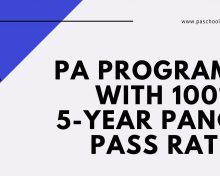As a PA School Applicant, Should You Worry About Class Size?
As a future Physician Assistant/Associate (PA), one crucial factor that may be a part of your PA school decision-making process is class size.
Large PA class (> 50 students) or small PA class (< 50 students), you find yourself contemplating which environment will be most conducive to your learning. This question, however, may not have a clear-cut answer, as the “best” class size often varies depending on individual learning preferences and styles.
I attended the Rutgers University PA program, where our class comprised around 40 students. In retrospect, the relatively small class size had a positive impact on my PA school journey. We were a close-knit group, akin to a family, right from the start. The camaraderie, support, and shared experiences fostered by our small class size played a pivotal role in shaping my development as a PA.
So, this leads us back to the original question, “Does class size really matter?”
From my personal experience, I believe it does, but the importance and implications may not be as straightforward as you might think.
The Impact of Class Size: The Bigger Picture
A larger class size in a PA program can be both a challenge and an opportunity. On one hand, it could mean less personalized attention from faculty, making it a less suitable environment for those who learn best through direct interaction. However, it also offers a unique set of benefits:
- Diversity of Experiences: Larger classes often draw students from a wide range of backgrounds. This diversity can enrich your learning experience, providing various perspectives on patient care and the field of medicine.
- Networking Opportunities: The larger your class size, the more extensive your network of future PAs. This can potentially lead to more job opportunities and collaborations in your professional future.
- Alumni Network: After graduation, a larger class translates into a broader alumni network. This network can be a valuable resource throughout your career, providing professional connections and opportunities.
The Value of Small Class Sizes: The Personal Touch
Smaller class sizes, on the other hand, tend to offer more individualized attention and direct interaction with faculty members, making them an attractive option for those who prefer a close-knit learning environment. The benefits of a smaller class include:
- Personalized Attention: In smaller classes, faculty can provide more individualized guidance and mentoring. This is beneficial for those who thrive under direct instruction and guidance.
- Close-Knit Community: Smaller classes often foster a sense of community among students. This camaraderie can be a source of emotional and academic support throughout the rigorous PA program.
- Active Participation: With fewer students, you’ll likely have more opportunities to participate in class discussions, ask questions, and engage with the material.
The Research on Class Size and Achievement
When contemplating the impact of class size on the learning experience and outcomes, it’s also essential to consider empirical evidence. Various studies have investigated the impact of class size on graduate student performance and retention.
- The Effects of Class Size on Student Performance and Retention at Binghamton University (1997) found that increasing class size had a negative effect on student achievement, with students in smaller classes being more likely to receive A’s and less likely to drop out.
- Class Size and Student Performance in a Team-Based Learning Course (2014) found that active learning pedagogies, which are more student-centered, were more effective in smaller class sizes.
- Does Class Size Really Matter? A Chalkbeat Look at the Research (2022) reviewed the research on class size and found that students often do better in smaller classes, but there is no clear consensus on the optimal class size.
These studies suggest that smaller class sizes can have a positive impact on student performance in graduate school. However, there are many more factors that also play a role in PA student success
Choosing What Works for You
The choice between larger and smaller class sizes ultimately boils down to your personal preferences and learning style.
If you’re comfortable in larger, more diverse settings and value a larger professional network, a program with larger class sizes may be beneficial. On the other hand, if you appreciate a more intimate learning environment with more one-on-one interactions, a smaller class size may be the best fit for you.
Remember, however, that class size is just one of many factors to consider when choosing a PA program. It’s equally important to consider the program’s curriculum, faculty, location, tuition, and the opportunities it offers for hands-on experience.
In the end, the ‘right’ PA program for you is the one that aligns best with your goals, values, and learning style. It will offer a blend of solid academics, hands-on experience, supportive faculty, and a learning environment that feels just like home.
Don’t get too caught up in the numbers game – look beyond the numbers to understand what each program truly offers.
Stephen Pasquini PA-C











































































































